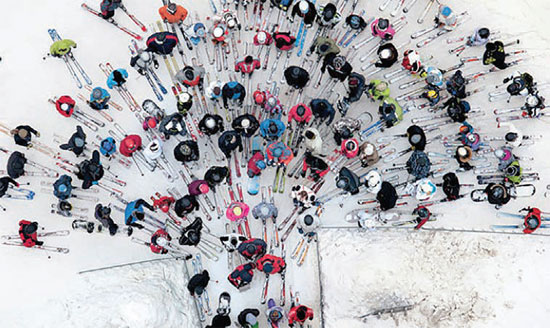By Brice Wallace
Last year’s ski season slipped from record skier visit levels the prior two years, but ski industry officials are optimistic that the upcoming season will represent a strong rebound.
“I’m looking forward to an awesome ski season,” Nathan Rafferty, Ski Utah’s president and CEO, said at a season-opening news media conference in Salt Lake City. “I think a little bit of that early snow we saw a week or two [ago] got people super-excited for ski season, and we’re looking forward to it.”{mprestriction ids="1,3"}
Last year’s skier visit total of 4.1 million was in the realm of the industry’s 10-year average and represented the state’s sixth-best season ever, despite being down 9.6 percent from the prior season. That compares with a national slippage of 2.8 percent.
“Last year’s ski season was a great one,” Rafferty said. “Despite some of the low snow totals, we had the second-best spending we’ve ever had in the history of our ski industry here.” Overall spending was over $1.3 billion for skiing and snowboarding activity.
Hampering the season was snowfall totals reaching just 60 percent of average.
“Snowfall, as many people know, was down across most regions, including Utah,” he said. “[It was] still a great ski season, and I don’t have to tell you to know when our snowfall is down, it’s well above many other regions’.
“And when I talked to people, they had a great time. And it’s always important to understand that when you come from New York or San Francisco or California, you get out on the perfectly groomed slopes and, as locals sometimes forget, you don’t need two feet of snow to have a great day out on the mountains, and plenty of people did.”
Particularly strong last season was out-of-state and international visitor spending. Their per-day spending rose to $377, up from the prior-season record of $309. This year’s domestic marketing efforts are focused on California, Texas, Florida and New York, while international marketing is targeting the U.K., Europe and Australia.
Among changes to ski passes this year are that the Passport program has gone fully digital. The program, in its 20th year, gives fifth-graders three days and sixth-graders one day of skiing or riding at each of Utah’s 13 resorts for $45. After applying online, the passes can be instantly redeemed for tickets without any printed media. Parents can join the students with a Yeti Pass, good for one day of skiing at each of Utah’s 13 resorts for $649.
Utah’s snowsports industry also will be spotlighted Feb. 1-10 as the bi-annual 2019 FIS Freestyle, Snowboarding and Freeski World Championships take place at Deer Valley Resort, Park City Mountain and Solitude Mountain Resort. “This event is one level down from the Olympics, so this is a big, big deal and we’re really excited,” Rafferty said, adding that “it should be the largest winter sport event that we’ve hosted since the 2002 Games.”
Among improvements at Utah resorts is Eagle Point Resort installing a snowmaking system. “It has been something that has needed to happen for a long time,” said Lane Tucker, base operations manager at Eagle Point. “And now with more residents coming on the mountain to make this more their winter home with developments that we have coming through, it’s the time to get it done.”
To help alleviate traffic congestion in the Little and Big Cottonwood canyons, the R.I.D.E. (Reducing Individual Driving for the Environment) program enters its third year.
“As our population grows and as more cars are on the road, it’s just naturally going to push more people up into the mountains,” said Brian Brown, communications manager at Snowbird. “It’s a big reason why a lot of people live here, go to school here. We certainly don’t want less people skiing and snowboarding. What the goal is with the R.I.D.E. program is to change their habits in how they arrive at the resorts. I don’t think it’s going to solve the traffic problems overnight or be the end-all cure, but it’s a really good first step.”
Participants who take the UTA Ski Bus or carpool with other people are rewarded with parking close to Snowbird Center and half-price lift tickets. This year, an app will help people find others willing to carpool to the resorts. Brown said the resorts “continue to find small battles that we can win as we face some population increases and try to do our part for the environment as well.”
Tentative opening dates for the season are Nov. 16 at Brian Head Resort; Nov. 21 at Brighton Resort, Eagle Point Resort, Park City Mountain and Snowbasin Resort; Nov. 23 at Alta Ski Area; Nov. 30 at Snowbird; Dec. 1 at Solitude Mountain Resort; Dec. 7 at Sundance Mountain Resort; and Dec. 8 at Deer Valley Resort. Dates for Beaver Mountain, Nordic Valley and Powder Mountain are to be determined.{/mprestriction}








